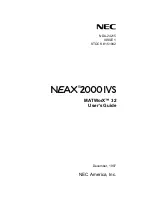
Crestron
e-control Mail SW-MAIL
67
••
Appendices
Installation & Reference Guide — Doc. 5798
The sender’s “real” name is
specified by the
SetFromName
signal,
or by the default specified
in the e-Mailer signal block
definition.
While most mail (SMTP) servers accept any account name (such as “anonymous”)
for outgoing mail, some servers only accept outgoing mail from a known account. In
these rare cases, the sender’s real name may be ignored by the SMTP server and
replaced with the name on record for that account. Or mail may be rejected by a
picky server if the specified name does not match the name on record exactly.
Error Reporting
At this time error handling is a little haphazard, with some errors being tallied back
to the control system, while others are logged in the
Server Monitor
window
.
Tallied Errors
A descriptive string is sent with all errors (via
ErrString
). However, while some are
accompanied with error numbers (via
ErrNumber
+
ErrTrigger
), some are not.
Log Items
The log is intended for after-the-fact analysis of important events. The log is an in-
memory FIFO list (first in, first out). When the log approaches capacity, log items
are removed, one by one, starting with the oldest items first, until there is enough
room for the new item.
All logged items are preceded with either a per-cent sign (%) or a dollar sign ($).
Items preceded with % are informational. Items preceded with $ are errors, reflecting
unanticipated situations.
Signal Summary
The “Signal Reference,” below, is an alphabetical list of all signals from COM ,
e-Mailer, and e-Mailbox signal blocks. (Signals from Scroller signal blocks are not
listed in this document. See the SW-DBM document, Doc. 5823.)
Certain signal names are used in all types of signal blocks. However, only one entry
for each signal type appears in the reference. Among these are the
Done
signal and
the three error signals (
ErrNumber
,
ErrString
, and
ErrTrigger
). This identical
naming reflects the fact that these signals function similarly regardless of where they
appear.
When these signals are defined in a signal block, the server uses them. When not
defined, however, the server sends the signal via the “owning” signal block. If the
signal is not defined there either, or the scroller has no owner, the signal is sent to the
COM Settings signal block. If the signal is also undefined in the COM Settings
signal block, the signal is lost (not sent).
Signal Block(s)
Signal Name
Direction
Type
e-mailbox
CheckMail
server-to-system
D
e-mailer
ClearNames
server-to-system
D
e-mailbox
Delete
server-to-system
D
All
Done
system-to-server
D
e-mailer
EchoBody
server-to-system
S
e-mailbox
EchoDate
system-to-server
S
e-mailbox
EchoFrom
system-to-server
S
e-mailbox
EchoRcpt
system-to-server
S
















































